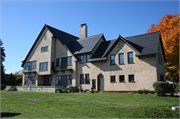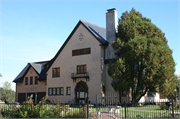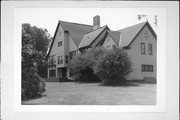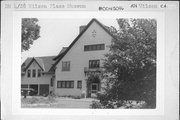| Additional Information: | A 'site file' exists for this property. It contains additional information such as correspondence, newspaper clippings, or historical information. It is a public record and may be viewed in person at the Wisconsin Historical Society, State Historic Preservation Office.
Site of the first white settlements, 1846. House was originally constructed in 1859. Remodeled in 1894, and then, taken down to the foundation and built anew in 1926.
1859-1892: Homesite of William Wilson, founder of Menomonie
1892-1921: Homesite of Sen. James H. Stout, founder of Stout University
1921-1974: Homesite of George LaPointe Jr., grandson of William Wilson.
A fountain on the property dates to the 1880s and was made in Buffalo, N.Y. The fountain was originally located in front of the building was moved in the 1940s for the construction of Highway 25.
2017-2018 Survey Report Recommendation Write-Up:
Comprised of a variety of intersecting gables, this two-and-one-half-story, Arts & Crafts-style house is sheathed with stucco. An open terrace fronts the house along its east (Broadway Street) elevation. At its approximate center and beneath a projection that extends up to the front-facing gable is a wood-and-glass door that is flanked by sidelights and trimmed with stone. To either side of the entry is a pair of French doors that also open onto the terrace, each of which is flanked by a pair of multiple-light casements. This same arrangement of French doors and flanking windows is found along the second floor (albeit the original north doors are now boarded over), with both groupings underscored by a decorative metal balconet with brackets. A tripartite window grouping is found above the entrance and a second, smaller grouping is found in the upper half-story. A side-gabled roof extends to the north and connects to the attached garage. Windows within these two sections are largely double-hung sash examples; however a line of three, square, fixed examples light the first floor of the garage wing. A wooden door set within a round-arched, stone-trimmed opening with a transom provides access to the former garage space. Despite the entrance along the east elevation, the main entrance is from the rear of the home and through a large door set within a round-arched, stone-trimmed opening with a large transom. Windows along the west side of the house are not as plentiful as on the east but they are also multiple-light examples, with the grouping above the west entrance also featuring a decorative metal balconet. Although the original three garage door openings remain evident, the central opening has been fitted with glass that includes a door (to access the space, which was converted for use as a gift shop). An interior inspection at the time of survey confirms that the house remains significantly intact.
Although a house has been on this parcel since 1860, the existing home attained its current appearance in 1926, while it was under the ownership of George W. Jr. & Irene LaPointe, the grandson of Capt. William Wilson, one of the four primary shareholders of Knapp, Stout & Co. Born in Detroit, Michigan, in 1873, George LaPointe Jr. graduated from the Shattuck Military Academy in Minnesota in 1893 and the law school at Cornell University in Ithaca, New York, four years later. Thereafter he engaged in the lumber business, operating small mills in the vicinity, while still residing with his parents. In 1911, LaPointe Jr. purchased the Wilson-Weber Lumber Company and organized the LaPointe Lumber Company. Five years later, the O & N Lumber Company was incorporated as a result of LaPointe’s acquisition of the John S. Owen Lumber Co. and the Northwestern Lumber Company. LaPointe initially served as secretary and manager of O & N. That same year (1916), LaPointe wed Irene Walker of Duluth, Minnesota, and shortly thereafter, they made their home in Menomonie’s Lake View Subdivision. However, the 1920 census suggests that they moved in with the widowed Angeline Stout (LaPointe’s aunt) and into the 1890s James H. Stout family home (the Queen Anne-style house that preceded the one at the subject location and which was remodeled from the circa 1860 Capt. Wilson home) or were located elsewhere on the Stout family parcel (there was at least one cottage located on the parcel at that time). Although the Stout home was donated to UW-Stout in 1922 for use as a women’s dormitory, it was determined that its conversion as such was not financially feasible and the house reverted back to the Stout family in 1924. During this time, the house stood vacant.
In December 1924, it was announced that the Stout home was going to be torn down to make way for a new subdivision—the Stout Addition. Planned by landscape architect Charles H. Ramsdell, the subdivision was to include seventeen lots, with seven located along the riverbank and three facing the lake. All historical accounts indicate that the Stout house was, in fact, torn down to the foundation (of the 1859-60 home of his grandfather Capt. Wilson); however, some interior finishes, including the mahogany staircase, were retained for the subject LaPointe home. The completed house (at least as far as its exterior) was featured in a September issue of American Lumberman, in which LaPointe stated, “Grandfather probably would turn over in his grave if he could see my house finished in stucco, but the style demanded stucco.” At the time of the article, LaPointe was identified as operating thirty-five lumber yards in Wisconsin and that he was among “the pioneers in this country in financing his customers on a monthly payment plan.” Among LaPointe’s positions held include director, treasurer and president of the Wisconsin Retail Lumberman’s Association; he was also a director of the National Retail Lumber Dealers Association for a number of years, serving as president in 1935. In 1917, he introduced the Builders’ Service Department to his lumber operations, where a draftsman would assist prospective home builders/buyers in the design of their home or making adjustments from an already published home plan. As a result of his efforts and accomplishments, LaPointe was an invited delegate to President Hoover’s conference on Home Building in Home Ownership that was held in 1931.
The LaPointes remained in the subject home until their respective deaths in 1951 and 1974. That same year, John and Jacqueline Dotseth purchased the house. Jacqueline, a nurse, intended to remodel the home for use as a nursing home/assisted living facility. However, upon learning the home’s extensive history, it was developed as a museum known as Wilson Place. Opened in 1976, it continuously operated with regular hours until recently; however, special tours are still given upon request. |
|---|
| Bibliographic References: | MENOMONIE DUNN COUNTY NEWS 6/28/1995.
Eau Claire Leader Telegram 12/19/2000.
Eau Claire Leader Telegram 8/4/2003.
Citations for 2017-2018 Recommendation information below:
“George W. LaPointe, Jr., President O & N, Dies,” Dunn County News, 25 July 1951, 1/1; “Wilson Place,” National Register Questionnaire (NRQ) submitted by Dave Micek, September 2005 and “Captain William Wilson House,” NRQ submitted by Eric J. Wheeler, June 2013, both NRQs on file at the Wisconsin Historical Society (WHS), Division of Historic Preservation (DHP), Madison, WI; Shirley Siegel Schulman, “Wilson Place Museum,” Booklet in site file for Wilson Place, Located at the WHS, DHP.
“Old Stout Home Giving Way to Progress of Day,” Dunn County News, 13 December 1924, 10; Curtiss-Wedge and Jones, ed., History of Dunn County, Wisconsin, 107; “Realm of the Retailer,” American Lumberman, 25 September 1926.
Tim Dotseth, Son of John and Jacqueline Dotseth, Conversation with Traci E. Schnell, October 2017. |
|---|




